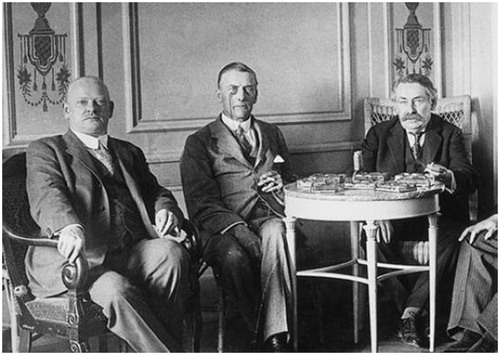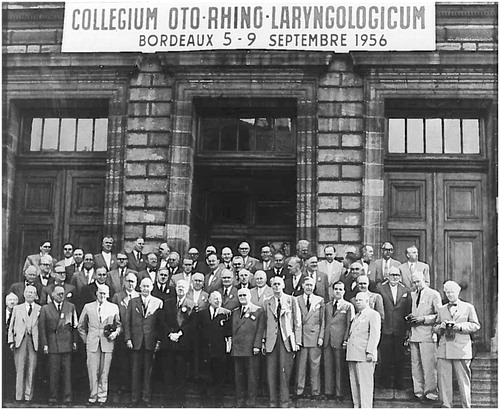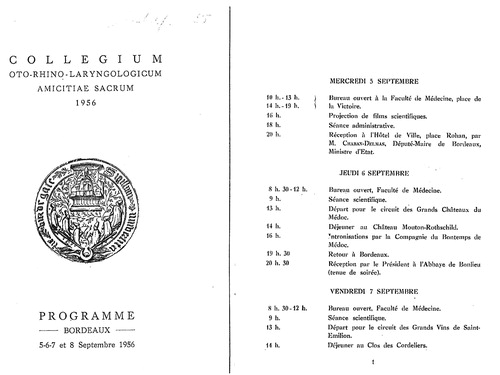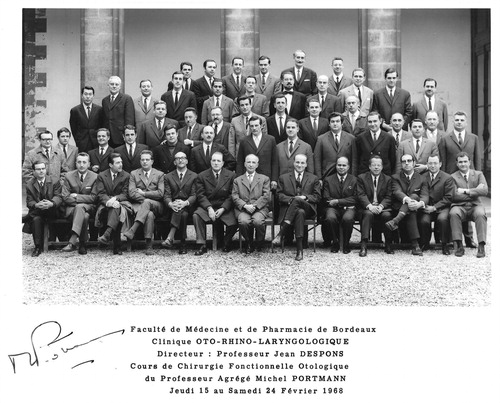It is a great honour and privilege to be invited to say a few words on the occasion of the 90th birthday of the Collegium. It is not accidental that this meeting takes place in Bordeaux. In this extraordinary place two earlier meetings were held, in 1931 the 5th anniversary, and 25 years later in 1956 the 30th anniversary. And now, after 60 years, we are in Bordeaux again in the 90th year of the Collegium. The history of our Collegium has been well documented in earlier publications [Citation1,Citation2].
Bordeaux stands out in many ways. Of course the city of Bordeaux is traditionally well known around the world as the prime hotspot for the best wines. If you have never tasted a Grand Cru, from the classification dating back to 1855, this meeting is the occasion to do that, of course after the meeting! We will certainly hear more about wine this week.
However, Bordeaux is also worldwide known as one of the eminent centres of otorhinolaryngology, with a special focus on Otology. The first professor in Otorhinolaryngology in Bordeaux was Emile Jules Moure (1855–1941). He was the father in law of Georges Portmann and the grandfather of Michel Portmann. Their history is closely connected with the history of the Collegium ().
Figure 1. Three generations of Portmann: Emile Moure (1855–1941), Georges Portmann (1890–1985) and Michel Portmann (1924–2016). Source: Michel Portmann, peintre (ISBN 2-9524987-0-9), with permission of the family Portmann.
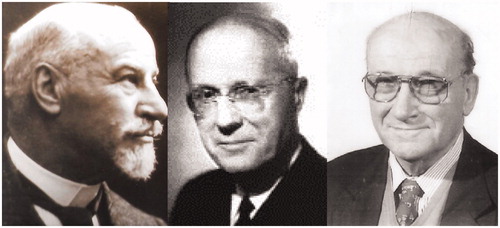
What would the Collegium be without the great men, on whose shoulders we stand today, what would the Collegium be without Bordeaux and without the name of Portmann.
I do not want to elaborate too much on history, as it has been well written, yet to meet in Bordeaux and not to mention the important role of the Portmanns is not imaginable. It starts with Georges Portmann and his essential role in the foundation of the Collegium. It were the French and also the Belgians who had suffered most from world war I, with millions of casualties.
It was Georges Portmann, one of the great men, who supported the reconciliation between French and German scientists in a new European otorhinolaryngologic scientific society, unique in the world. The ‘Amicitiae Sacrum’, introduced by Burger, professor in Amsterdam, accentuated the significance of international cooperation. The foundation meeting in Groningen, in October 1926, was attended by 34 physicians of our specialty from 10 different countries, amongst them two from France, Portmann from Bordeaux and Mouret from Montpellier ().
Figure 2. Foundation meeting in Groningen, 9–11 October 1926. Front row, L to R: Barraud, Barany, Voss, Zwaardemaker, Burger, Mouret, Portmann, Gray, Marshik, standing on the right: Benjamins. Source: Archives of the Collegium.

This was a really historical meeting and Huizinga, then the young assistant to Professor Benjamins, one of the founders, mentions the famous dinner speech by Georges Portmann. He spoke of a ‘Une Locarno Scientifique’, referring to a meeting between the foreign ministers of France, Germany, and Great Britain: Aristide Briand, Gustav Streseman, and Austen Chamberlain, who met shortly before (1925) in Locarno to discuss reconciliation between European countries after world war I. Briand and Streseman received the Nobel prize for peace in 1926 (Chamberlain already received the Nobel prize in 1925).
He quoted Aristide Briand, one of the greatest French politicians ():
Les savants luttent pour nous préserver de la tuberculose, du cancer et la guerre, l’horrible guerre serait le seul mal contre lequel l’humanité se déclarait impuissante. Je veut pas le croire! [Everyday scientists fight to protect us from tuberculosis, cancer: should war—horrible war—be the only disease against which mankind declares itself powerless, I do not want to believe this.]
Perhaps nice to mention that Portmann’s speech was in French, at that time with German the most prominent scientific language, and as you know also one of the three official languages of the Collegium.
Georges Portmann was a giant in his time, he made many contributions in our field. His studies on the endolymphatic sac and the surgical decompression as treatment for Menière’s disease stand out as classic contributions. He was also a member of the National Senate in Paris.
In 1931, Georges Portmann was President of the first Collegium meeting in France ().
Figure 4. Collegiummeeting Bordeaux, 9–11 July 1931. First row, L to R: Thornvall, Barraud, Guild. Gray Ledoux, Portmann, Benjamins. Tweedie, de Kleyn, Prechtel and Nager. Source: Archives of the Collegium.

The attendance of 33 members was low, mainly because of the economic crisis. Of the 22 papers announced in the programme, eight had to be cancelled because of travel restrictions of the members. In spite of this it was regarded as an excellent meeting because more time was left for fruitful discussions. The social programme was also very important. The scientific programme was only in the morning and so enough time was left for visits to highlights in the region. This included visits to the famous wine region and as a highlight a visit to the Abbaye de Bonlieu.
The programme and abstracts were printed in the three official languages ().
There was an equal number of French and German presentations and only two in English, one by Tweedie from Nottingham (England) and one by Guild from Baltimore (MA), as a guest of the Collegium. There were no American members yet. Actually, French was the lingua franca, but also German was important. In the report of the meeting by Benjamins, the role of Professor Nager from Zürich was praised for his simultaneous translation of the papers and the discussions. This was absolutely necessary because not all the members were proficient in all three languages. Only much later did English become the predominant language, and is now the universal scientific language, to the regret of certain people in the Collegium.
The next meeting in Bordeaux was in 1956, with also George Portmann as President (). He was the only member in the history of the Collegium who has been President twice in the same place 25 years apart. This was also the meeting in which his son Michel Portmann was proposed and accepted as a new member of the Collegium.
The meeting was attended by 78 members and honorary members from 25 countries.
The opening of the meeting by the President highlighted the most important points of the history of the Collegium. The scientific meeting was held in the mornings, in spite of some earlier criticism as to whether the Collegium was not in this way following the wrong path: too little science and too much entertainment. However, those present testified that this was unjustified and, according to the report of the meeting by the General Secretary, the contributions to the scientific programme were of very high quality ().
The social programme also pleased members, with different visits to the great wine houses of Bordeaux: A lunch at Chateau Mouton-Rothschild, and a reception at Chateau Iquem ‘the king of wines, the wine of kings’ (Report of the General Secretary). The Bordeaux family with the young Michel and Claudine were thanked for their enormous efforts to make this meeting so successful.
And now we stand here again after 50 years commemorating the role of Bordeaux and the Portmanns in the history of the Collegium.
It is very sad that Michel Portmann cannot be here today. With his 93 years of age and suffering from a serious illness, his condition does not allow him to be present. Of course we all regret this very much and can also wish improvement of his health. Michel Portmann was born in 1924 and after training succeeded his father in many ways. He became one of the leading otologists of the world and has trained a large number of otologists around the world. For me this dates back to the winter of 1968 when I attended the otology course in Bordeaux ().
This course at that time was unique, given in English (and in Spanish) lead by Michel Portmann, helped by Guy Lacher, also a gifted surgeon. The impression Michel gave was one of extreme dexterity in surgery, but also firm conviction to convey his message and also his results. His analysis and speeches after the surgery in his white monkshood were fantastic, his drawings with two hands at the same time made an unforgettable impression. His natural talent is still also visible in his after work career as a painter (later).
One of his personal operations was the Stapes interposition with the crus posterior. Very ingenious, and certainly more difficult than the present stapedectomy.
He served the Collegium as a treasurer from 1967–1991 and I can assure you that the money of the Collegium was in safe hands in spite of the repeated devaluation of the French Franc. All members of the Collegium are extremely grateful for the eminent way he has served the Collegium and our specialty over so many years.
Figure 9. Michel Portmann as a painter. Source: Michel Portmann, peintre (ISBN 2-9524987-0-9), with permission of the family Portmann.
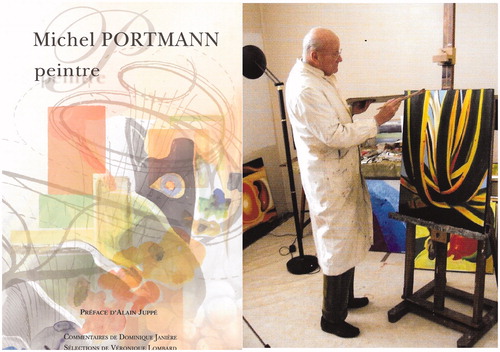
Finally, I would like to elaborate a little on his natural talent for painting, In 2005 a book with 200 paintings was published (). It is a wonderful book which gives an excellent overview of the big talents Michel Portmann inherited from his grandfather Moure and developed further after his retirement in 1995.
The following pictures are taken from the book and show the diverse and creative talent of the master. It is not up to me to analyse these works taken from professional life, nature, or allegoric fantasies, but this work is very impressive (). Quoting Mario Puzo, the author of the Godfather: ‘Great men are not born great, but they grow great’, and this is surely true for Michel Portmann.
Figure 10. Paintings from the book, Michel Portmann, peintre. Source: Michel Portmann, peintre (ISBN 2-9524987-0-9), with permission of the family Portmann.
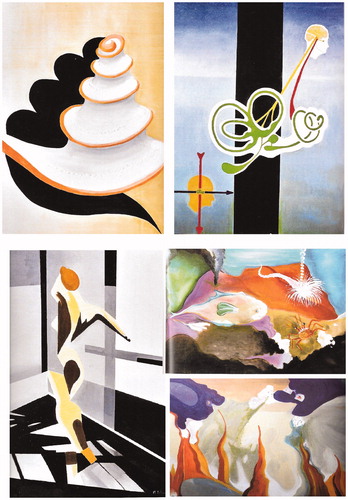
We live in a turbulent time today, perhaps no war now here in Europe, yet many heavy conflicts around the globe threatening the lives of many people. The peace after World War I was sadly not lasting, in spite of the courageous activity of many, also in the Collegium. After World War II, great men forged an International movement of peace, resulting in what we call today the European Union. German and French men like Adenauer and Shuman were instrumental in forging international co-operation and friendship and, in spite of failures and criticism, The European Union is the result of a unique experiment in history, bonding so many countries who had been at war for many centuries and now have lived in peace for more than 70 years.
In that way the founding of the Collegium was also a big experiment because of its unique background. In spite of criticism it has survived 90 years! The meetings were suspended during World War II and resumed in 1948. It is now a worldwide international community with the aim of sharing fundamental research, always in an informal way in an atmosphere of friendship. I am sure this will last for a very long time: VIVAT Collegium Otorhinolaryngologicum Amicitiae Sacrum.
Endnote
The author received the message that Michel Portmann died on 16 September 2016.
Disclosure statement
The author reports no conflicts of interest. The author alone is responsible for the content and writing of the paper.
References
- Huizinga E. Acta Oto-laryngologica (Suppl. 215).
- Huizing EH, van den Broek P. Vivat Collegium Oto-rhino-laryngologicum Amicitiae Sacrum 1926?2002 (jubilee edition, supported by Acta).

